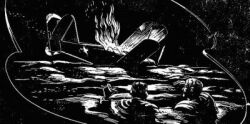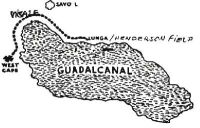|
At 2200 on Oct. 11 1942

 W. J. Tate Jr., Lieut.
and
W. J. Tate Jr., Lieut.
and

 Claude W. Morgan, ARM1c were catapulted
from the USS Salt Lake City about nine miles off West Cape, Guadalcanal.
It was a dark night and the ground crew had loaded extra flares in the rear
cockpit lengthwise instead of athwartship as instructed.
Claude W. Morgan, ARM1c were catapulted
from the USS Salt Lake City about nine miles off West Cape, Guadalcanal.
It was a dark night and the ground crew had loaded extra flares in the rear
cockpit lengthwise instead of athwartship as instructed.
The acceleration experienced when the aircraft was catapulted caused the
flares to fall out of their storage, setting the tail of the plane on fire.
It never got above 200 feet, and within seconds the fire was spreading
through out the entire aircraft. Morgan had to immediately crawl out of the
rear seat onto the wing and Tate couldn't see the water, horizon or even
the instrument panel, He gunned the engine two or three times trying to
blow the fire out and eased down toward the water trying to land in a
cross wind.
The airplane hit the water right wing down and didn't bounce,
throwing Morgan clear, however he received a bad cut over one eye and a
wrenched shoulder. The plane was still on fire and Tate was out on the
wing before his head began to clear, he did not remember unbuckling his
safety belt or climbing out of the cockpit. He suddenly became afraid that
the gas tanks might explode, so he swam over to join Morgan and together
they swam about 200 feet clear of the aircraft. They tried to signal the
ship with a pencil light but didn't have any luck.
The fire burned for about seven more minutes before the plane turned over
and put it out. They swam back to the plane, Morgan held onto the tail
trying to relax the pain in his wrenched shoulder while Tate extracted the
life raft, it took about 10 or more dives down to the compartment it was
stowed. The life raft had survived the fire and inflated properly, which
was a good thing as Tate had torn up his life jacket so badly extracting
the raft, he had to throw it away. He also got gasoline, that was floating
on the surface of the water, in his eyes and swallowed some which
immediately made him sick.
They climbed into the raft and started paddling away from the plane toward
the west end of Guadalcanal, as enemy troops were all along the shore where
they now were and it would be impossible to land and walk to Lunga. About
2330 they witnessed the battle of Cape Esperance. It appeared to them as
though three groups of ships, with our ships in the middle and shooting in
both directions.
It got very cold that night, even though they were fully clothed, except
Tate had discarded his helmet and gloves which later proved to be a mistake,
at daylight they were about five miles off West Cape. For provisions they
had five bottles of Horlick's malted milk tablets and two gallons of water.
Morgan had bought the canteen at a hardware store and Tate the malted milk
tablets in Honolulu with their own money. This was all they would eat,
except for floating coconuts they managed to fish out of the water, the
next three days.
The first day they continued paddling, keeping about six miles off shore
hoping to be spotted by some of our planes looking for survivors, but no
such luck, even though six planes flew directly four hundred feet overhead
on a strafing run toward Japanese targets. To the north a destroyer and
some planes could be seen picking up survivors from the destroyer
SS Duncan, which was our only ship sank in the battle of Cape Esperance.
Life in the raft was always wet as waves would slop in and they could never
get completely dry. It was cold at night and hot during the day. Tate had
to remove his underwear, tear it up and cover his head, face and hands to
protect them from the sun and help warm them at night. His hands and face
was tender from the gasoline burns received while diving to get the raft
out of the airplane, he now wished he hadn't discarded his helmet and
gloves. Morgan's wrenched shoulder and cut above his eye seemed to get
better with time.
The second day they found a dugout canoe with a hole in it, patched it up
and tried paddling it towing the raft. It went faster but was so
delicately balanced and difficult they went back to the raft. By afternoon
they managed to get around the west tip of the island and a fresh wind came
up which eased the burden of paddling but blew them within a half mile of
the shore. A Japanese sniper opened up on them and they promptly went
overboard. He fired about 10 rounds but the closest landed about six feet
away. The swimming cooled them off and they felt much better. As they
paddled away they noticed a number of power boats and barges badly damaged
on the beach. That evening another rubber boat could be seen coming from
Savo island which started chasing them, it was some Japs bringing back
fruit and vegetables so they easily out distanced them. Tate and Morgan
had only a sheaf knife and five pen knives, they wouldn't have been much of
a match for anyone with a gun. The Japs didn't fire at them but one from
Visale, on Guadalcanal, tried his luck but didn't come very close.
Early on the third night ships started firing at Lunga and received
answering fire from shore. Later three Destroyers passed just east of
Savo island and a few minutes later a Japanese destroyer came around the
west side headed straight toward the two men in the raft. They held their
breath and just before it got to them the destroyer veered off but still
passed so close, Morgan and Tate could hear them talking. It was doing
ten or twelve knots and came close enough to nearly swamp their raft even
though it was a calm sea that night.
Shortly after a large campfire and light appeared on the beach, obviously
to give navigational aid to the Japanese, as ships started bombarding Lunga
beach. They received return fire than swung toward Tulagi and fired
briefly and retired to the north. They were accompanied by a Japanese
battleship and as soon as they retired the large campfire and light on the
beach went out.
On the last day both men felt quite sick from the sun but kept paddling
toward Lunga, their progress became difficult as a southwest wind
necessitated that one to bail out water as the other paddled. All day the
two men in the raft watched our planes bomb Japanese positions but finally
turned toward shore, and right in the nick of time! A Higgins boat spotted
them and picked them up. For the two men in the raft the Battle of Cape
Esperance lasted sixty seven hours and covered fifty miles.
|


